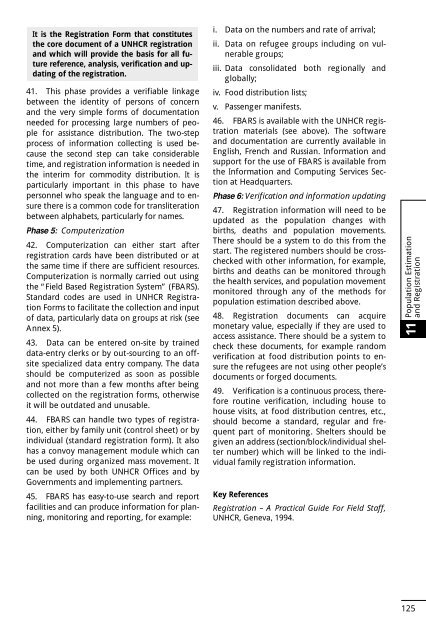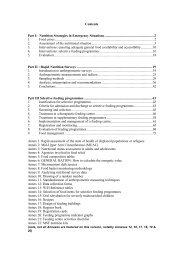UNHCR Handbook for Emergencies - UNHCR eCentre
UNHCR Handbook for Emergencies - UNHCR eCentre
UNHCR Handbook for Emergencies - UNHCR eCentre
You also want an ePaper? Increase the reach of your titles
YUMPU automatically turns print PDFs into web optimized ePapers that Google loves.
It is the Registration Form that constitutes<br />
the core document of a <strong>UNHCR</strong> registration<br />
and which will provide the basis <strong>for</strong> all future<br />
reference, analysis, verification and updating<br />
of the registration.<br />
41. This phase provides a verifiable linkage<br />
between the identity of persons of concern<br />
and the very simple <strong>for</strong>ms of documentation<br />
needed <strong>for</strong> processing large numbers of people<br />
<strong>for</strong> assistance distribution. The two-step<br />
process of in<strong>for</strong>mation collecting is used because<br />
the second step can take considerable<br />
time, and registration in<strong>for</strong>mation is needed in<br />
the interim <strong>for</strong> commodity distribution. It is<br />
particularly important in this phase to have<br />
personnel who speak the language and to ensure<br />
there is a common code <strong>for</strong> transliteration<br />
between alphabets, particularly <strong>for</strong> names.<br />
Phase 5: Computerization<br />
42. Computerization can either start after<br />
registration cards have been distributed or at<br />
the same time if there are sufficient resources.<br />
Computerization is normally carried out using<br />
the “Field Based Registration System” (FBARS).<br />
Standard codes are used in <strong>UNHCR</strong> Registration<br />
Forms to facilitate the collection and input<br />
of data, particularly data on groups at risk (see<br />
Annex 5).<br />
43. Data can be entered on-site by trained<br />
data-entry clerks or by out-sourcing to an offsite<br />
specialized data entry company. The data<br />
should be computerized as soon as possible<br />
and not more than a few months after being<br />
collected on the registration <strong>for</strong>ms, otherwise<br />
it will be outdated and unusable.<br />
44. FBARS can handle two types of registration,<br />
either by family unit (control sheet) or by<br />
individual (standard registration <strong>for</strong>m). It also<br />
has a convoy management module which can<br />
be used during organized mass movement. It<br />
can be used by both <strong>UNHCR</strong> Offices and by<br />
Governments and implementing partners.<br />
45. FBARS has easy-to-use search and report<br />
facilities and can produce in<strong>for</strong>mation <strong>for</strong> planning,<br />
monitoring and reporting, <strong>for</strong> example:<br />
i. Data on the numbers and rate of arrival;<br />
ii. Data on refugee groups including on vulnerable<br />
groups;<br />
iii. Data consolidated both regionally and<br />
globally;<br />
iv. Food distribution lists;<br />
v. Passenger manifests.<br />
46. FBARS is available with the <strong>UNHCR</strong> registration<br />
materials (see above). The software<br />
and documentation are currently available in<br />
English, French and Russian. In<strong>for</strong>mation and<br />
support <strong>for</strong> the use of FBARS is available from<br />
the In<strong>for</strong>mation and Computing Services Section<br />
at Headquarters.<br />
Phase 6: Verification and in<strong>for</strong>mation updating<br />
47. Registration in<strong>for</strong>mation will need to be<br />
updated as the population changes with<br />
births, deaths and population movements.<br />
There should be a system to do this from the<br />
start. The registered numbers should be crosschecked<br />
with other in<strong>for</strong>mation, <strong>for</strong> example,<br />
births and deaths can be monitored through<br />
the health services, and population movement<br />
monitored through any of the methods <strong>for</strong><br />
population estimation described above.<br />
48. Registration documents can acquire<br />
monetary value, especially if they are used to<br />
access assistance. There should be a system to<br />
check these documents, <strong>for</strong> example random<br />
verification at food distribution points to ensure<br />
the refugees are not using other people’s<br />
documents or <strong>for</strong>ged documents.<br />
49. Verification is a continuous process, there<strong>for</strong>e<br />
routine verification, including house to<br />
house visits, at food distribution centres, etc.,<br />
should become a standard, regular and frequent<br />
part of monitoring. Shelters should be<br />
given an address (section/block/individual shelter<br />
number) which will be linked to the individual<br />
family registration in<strong>for</strong>mation.<br />
Key References<br />
Registration – A Practical Guide For Field Staff,<br />
<strong>UNHCR</strong>, Geneva, 1994.<br />
Population Estimation<br />
and Registration<br />
11<br />
125



